Understanding the combat design of Lizard boss fight in Spiderman 2

The Lizard boss battle in Marvel’s Spiderman 2 is one of the more interesting boss battles in the game. It not only fulfills multiple functions that define a good boss fight in a video game but it’s also one of the best on screen renditions of the Lizard character. This is why I decided to break down the combat design of this boss to see what it does well.
This is also my first combat design article so I will be looking into a lot of combat design fundamentals of the attacks like anticipation, recovery, interrupting, stun-locking, hit-reacts and so on, so bear with me if you are already familiar with those.
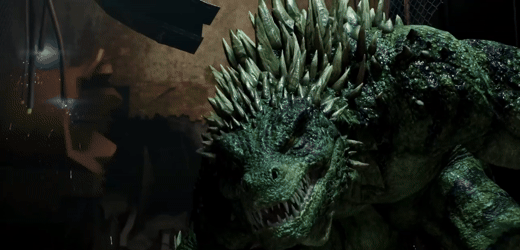
I break down the article into following sections to analyze the boss fight:
- What makes a good boss fight?
- The Boss battle
i. Phase 1 — Attack 1, Attack 2, Attack 3, Attack 4, Phase 1 design goals
ii. Phase 2 — Attack 5, Attack 6, Phase 2 design goals
iii. Phase 3 — Phase 3 design goals
iv. Phase 4 — Attack 7, Attack 8, Phase 4 design goals - Lizard Attack Sheet
- Balancing attack types
- Does the Lizard boss fight have the characteristics of a good boss battle?
- Good combat design takeaways from this boss fight
- Further resources
1. What makes a good boss fight?
As is the case with a bunch of my other articles, I like to take a look at what design goals the game is trying to achieve for whatever I am analyzing before diving into the details.
In general, a well designed boss battle can have one or more of the characteristics listed below:
i. to test a player’s mastery of a set of current skills.
ii. to teach the player a new skill.
iii. to surprise the player with a unique piece of gameplay experience.
iv. to advance the game’s story.
The Lizard battle fulfills all of these roles in one way or another thus making it a rather unique experience in the game. Let us now look at the flow of the battle and each phase in detail. We will also see how each of the above mentioned goals are achieved.
2. The boss battle
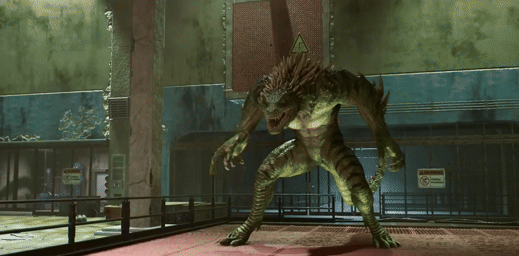
The battle is divided into four different phases, three fight phases and one chase phase. Each fight phase is defined by a full health bar that the player has to deplete in order to move the fight to the next phase. The third phase is the chase sequence.
i. Phase 1
The first fight phase is relatively simple. It starts by introducing an unblock-able attack that can only be dodged. This is the first time the game introduces an unblock-able attack thus making this more of a tutorial phase for the upcoming fight phases and future combat encounters. To keep this phase relatively simple, there are three other melee attacks that Lizard uses- one close range heavy tail whip attack, one close range light slash attack combo and one mid range lunge attack. Depleting Lizard’s health bar in this phase triggers the second phase.
Attack 1: Unblock-able Crush attack
This is the most powerful attack that Lizard uses during this phase of the fight. Lizard lunges at the player with the crushing force of its jaw to deal massive amounts of damage. The phase starts by Lizard attacking immediately with this unblock-able ‘Crush’ attack which needs to be dodged and cannot be blocked or parried.
For the first attack the game freezes and a tutorial text card pops up allowing players to clearly understand the biggest threat of this phase of the fight.
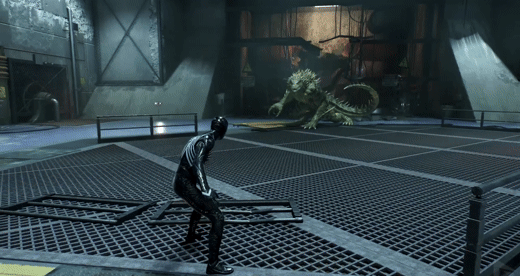
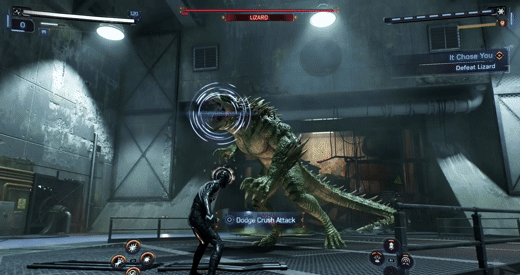
Anticipation:
The anticipation frames of this attack are accompanied by a blue ring around the Lizard’s mouth thus building clear expectations for the player. For subsequent uses of this attack after the first one, the anticipation frames are just about a 1 second long which is a good amount of time for the player to pick up on the attack and dodge it in time.
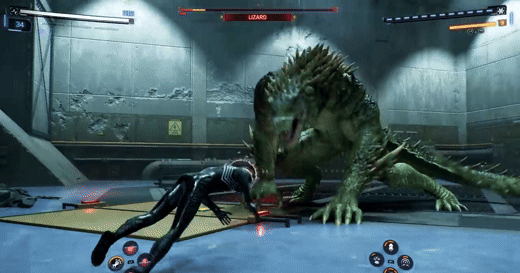
Recovery:
The recovery frames (time taken by the Lizard to reorient himself to the player to start attacking again) for the Crush attack are about a second long as well which gives the player enough time to start attacking and get in a basic attack combo.

Interrupt:
This move cannot be interrupted by the player and forces them to most certainly dodge, thus lending to the goal of checking their mastery of dodging.
Risk/Reward:
The balance between the recovery and anticipation frames works really well because there is just about enough time to dodge and dodging successfully gives a huge reward by allowing the player to finish out an entire attack combo which contributes to the easiness of the phase.
Attack 2: Light Slash attack
This is the most basic attack in Lizard’s move-set. It is a close range attack where Lizard performs a right and left slash in quick succession. This attack can either be dodged, parried or blocked. The player can also interrupt this move as long as the move has not made contact with the player.
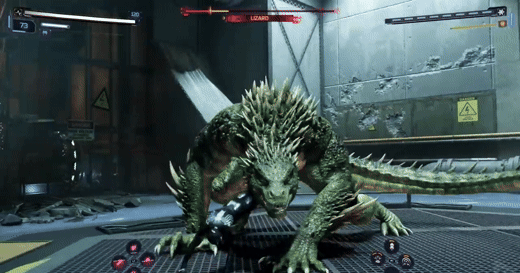
Anticipation:
The anticipation frames for the first slash are about 0.6s long and 1.2s long for the second slash (includes recovery time for the first one). The frames are longer for the second slash to provide the player enough time to recover if they get hit by the first slash without locking them into getting hit by the second slash automatically. This setup makes sure that the attack does not feel very punishing since this is one of Lizard’s most basic attacks.
Recovery:
It takes the Lizard about 0.6s to recover from the first slash but it also becomes a part of the anticipation time for the second slash. So the actual recovery time of the attack would be about 1.0s after the second slash which again gives enough time to the player to recover if they get hit by the second slash.
Interrupt:
This attack can be easily interrupted both during the first slash as well as the second slash. If the player interrupts during the attack during the first slash, the second slash automatically gets cancelled.
Skill check goals:
Since this attack can either be parried or dodged, it focuses on mastery of either quick dodging in succession and multiple parries in a row.
Other takeaways:
Notice the slash VFX. They are not really necessary since this is a basic attack but it sells the attack, its movement and the ferociousness of the character so well. It adds “juiciness” to that attack animation.

Attack 3: Light Lunge attack
When Spiderman hits the Lizard multiple times and the Lizard gets locked in a corner, Lizard performs a quick getaway jump to the other side of the arena, reorients himself and lunges at Spiderman for a quick single slash.
Lizard can also use this attack to quickly get to the other side of the arena if the player is trying to run away and force them to battle in close quarters. This attack also prevents Lizard from getting stun locked and creates some space between him and Spiderman. This prevents Spiderman to get in unlimited amount of hits and finish the phase without an interesting fight.

Anticipation:
After jumping away from the player, Lizard will most likely perform the lunge attack. So we start counting the anticipation time as soon as the Lizard lands on the other side. The anticipation frames here last about 1.3s which is ample amount of time for players to stop button mashing attacks and get in a quick dodge, which is another way of saying break their flow and force them to make a quick decision based on the incoming attack.
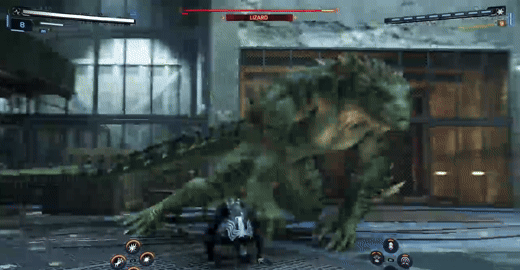
Recovery:
The recovery frames here take about 1.5–2.0s which is a massive amount of time. Looks like the attack is specifically made to let the player have a huge opening to attack back and get in quite a few hits before the Lizard starts another attack.

Range:
This is a mid range attack in contrast to all the other attacks in this phase which are close range. The first phase does need to be an easy one and Lizard is a better close range fighter so it makes sense for him to start using his close range attacks right away. But Spiderman is good at fighting at both close and mid-range. Webs and gadgets cover most of his mid-range arsenal. So if the player tries to keep going away from the Lizard, he can quickly use this attack to reach the player and force him to fight close range.
Skill check goals:
This attack can either be dodged, parried or blocked. Since it is a single attack, it uses the basic combat mastery of the player.
Attack 4: Heavy tail whip attack
The last attack in Lizard’s move-set for the first phase is a heavy tail whip attack. Lizard performs this attack using his tail, obviously, which is in contrast to the rest of his attacks that use his teeth and claws mainly. This attack shows off the sheer size and ferocity of this creature.
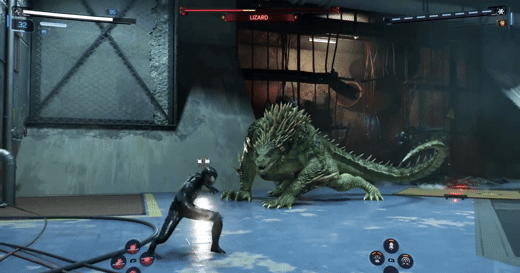
Anticipation:
Since this is a heavy attack, it’s anticipation frames are accompanied by a yellow ring. The anticipation time for this attack is about 1.2s as well, which is even more than the crush attack since getting hit by this one can not only throw the player far away but lock the player into a 2s recovery animation which is pretty long in a boss fight. So higher anticipation time is necessary to balance out the stronger hit reaction for the player.
Recovery:
Compared to other attacks, Lizard recovers a lot quicker from this attack. It only takes about 0.8s for Lizard to recover, once he makes contact with this move. Since the player gets thrown far away, a quicker recovery time gives Lizard more time to cover ground between him and the player.
Interrupt:
A heavy attack cannot be interrupted and thus needs to be either dodged or parried, thus lending to the goal of checking their mastery of dodging or parrying.
Phase 1 combat design goals
- Introduce the character and get the player familiar with it’s basic attack move-set, their timings and overall movement timing of the character. Overall movement timing is comprised out how quickly the character moves around the arena, how long are their hit-react animations, how frequently they attack the player, etc.
- The first phase focused on mainly close-range combat with occasional mid-range combat opportunities, thus focusing the player’s attack skill check on close quarters melee attacks and symbiote abilities.
- Since two out of four attacks could be blocked and three out of four could be parried, the player’s defensive skill check focus was more on improving the speed of players’ dodging and parrying skills.
ii. Phase 2
As the player enters this phase, Lizard regains all of his health. This fight phase is very similar to the first one. Lizard still uses the same three melee attacks as well as the newly taught unblock-able attack.
On top of the attacks used in the previous phase, there are two new attacks added to the Lizard’s arsenal. Another addition to this phase is the use of verticality in the boss fight by having Lizard jump up and move around on the walls, and attack players from a distance.

This phase also adds a strategic element to the battle. Whenever the Lizard started running on the walls, the player is expected to get in a few attacks from a long range and then bring him down to the ground to continue the fight. Rather than using only brute force, this fight forces the player to be cautious about their choice of attack and makes the player change their thinking and approach to the fight.

Attack 5: Wall crush attack
This is a variation of the crush attack introduced during the first phase. While the Lizard is running around on the walls above the player, he will suddenly beeline towards the player with a faster crush attack.
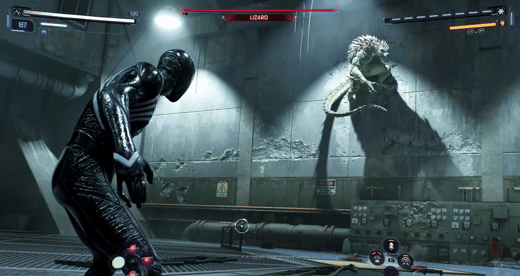
Anticipation:
Right before beginning to attack, the Lizard lets out a roar while on the wall and then immediately jumps down at the player. The frames with the blue ring around Lizard’s head, signaling the unblock-able attack, add up to about 0.5s and if we count the roar towards the anticipation time, it adds up to almost 2s of anticipation time. This is a good advantage to the players paying attention to the creature and its mannerisms and not just looking out for the rings around the Lizard’s head.
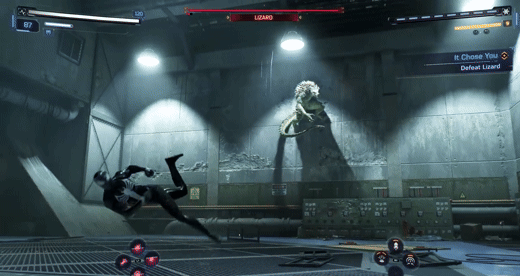
Recovery:
This is meant to be an advanced attack so the Lizard recovers pretty quickly from it as well. The recovery frames add up to about 0.6s as well. So the player really needs to start attacking in that short time frame to get the maximum number of hits in.
Interrupt:
This move cannot be interrupted by the player and forces them to dodge even faster in this phase.
Skill check goals:
Since the attack has even less anticipation time than the original crush attack, this attack focuses on improving the player’s dodging skill.
Attack 6: Concrete projectile attack
This projectile attack is the first long range attack that Lizard uses. Lizard stays up on the wall, pops out a piece of concrete from the wall and throws it at the player. This attack breaks up the players fight strategy from constantly using melee attacks or close range abilities and forces them to use webs while Lizard attacks from far away.
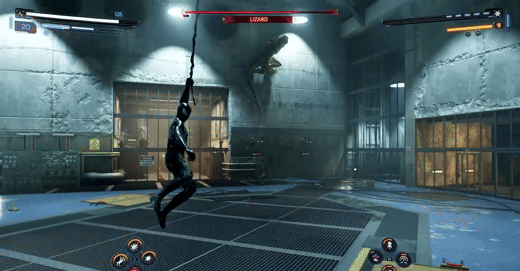
Anticipation:
Since this is more of a surprise attack for the player, it has an absurdly long build up to the attack. The Lizard claws at the wall for about 3 seconds before actually throwing the rock. The air time for the rock is 0.6s before it makes contact with the player.
Recovery:
Lizard usually waits for a couple of seconds for the player to recover after being hit. The Lizard’s recovery animation itself is about 0.5s long and its negligent compared to the player’s recovery time. Less recovery time on the Lizard’s part also gives it a chance to quickly reposition itself on the walls around the room.
Interrupt:
If the Lizard is attacked with webs or gadgets from faraway, this attack can be interrupted but not once the concrete block is in the air. So there is a very short timing window to interrupt this attack.
Skill check goals:
Since this attack can only be dodged, it continues to test the player’s ability to dodge quickly. Along with dodging, players need to focus on webbing up Lizard and master their use if long range attacks.
Phase 2 combat design goals
- Build on the current Lizard move-set by adding completely new moves or introduce a new take on existing moves. Surprise the player with a completely new and unexpected move (long range concrete projectile attack).
- Since we have a new and faster form of the unblock-able crush attack added to this phase, the goal is to increase the player’s skill level of being able to dodge these heavy damaging moves in time.
- This phase also pushes the combat to have a better balance between close range and long range opportunities by having the lizard run on the wall. So this phase also started testing the player’s long range combat skills while increasing the difficulty of close range attacks like the new and improved wall crush attack.
Before we move on to phase 3, let’s ask a necessary question here:
Why two phases instead of breaking down the same health bar into two parts?
I came up with a couple of reasons:
- These phases need to collectively introduce SIX attacks to the player which will be much harder to learn if introduced to the player at the same time.
- A lot of dialogue needs to be delivered by Peter to build up frustration leading to last phase which requires a lot more time that seemed difficult to cover with one health bar. So why not reduce the damage amount per attack to provide more time? A comparatively slowly reducing health bar gives the player the feeling that the boss is much harder than it actually is, which is probably not the goal here. The boss fight is manageable but dangerous if the player is not paying attention.
iii. Phase 3
After depleting the Lizard’s second health bar, he flees the area and Spiderman needs to go after him and catch him. This phase is a chase sequence and tests the traversal skills of the player rather than their combat skills. It also provides a nice break for the player from the continuously fighting the same monster with three health bars.

Phase 3 design goals
- Provide relief to the player from continuous combat and skill check their traversal abilities.
- Adding this sequence provides context for a new and challenging attack for Spiderman- the roar attack that stuns the player.
- Further build up the narrative tension and frustration between the characters.
iv. Phase 4
Now we come to the final phase of the Lizard boss fight. This is the final health bar of the boss that the player needs to deplete to wrap up the overall boss fight. In addition to the six attacks that we have taken a look at, this phase introduces two new attacks. The first one is the scream attack that was contextualized during the chase sequence in phase 3 and the second is a quick vertical tail slam.

This phase is the culmination of everything that the player has learned so far from the first three phases. Consider the first three phases as more of a tutorial for this final phase. This phase is also harder than the previous ones and we will look at a number of reasons for this later on.
Attack 7: Scream attack
The scream attack was contextualized during phase 3 where Lizard screams at the player, and if the player gets caught in the scream cone, then the Symbiote suit gets immobilized and the player is unable to move for a few seconds leaving the player vulnerable to a few big hits.

This is also an unblock-able attack and is accompanied by a blue ring around the Lizard’s head during the anticipation frames.
Anticipation:
The anticipation frames are about 0.8s which is not much time for an unblock-able attack, especially for one of the most dangerous attacks in the boss’ arsenal. The lower anticipation time for a high punishment move lends to the higher difficulty of the phase.
Contact:
Unlike the other attacks, this is a continuous scream attack that can take a few seconds while maintaining contact with Spiderman. All the other attacks hit the player once, hence their contact frames are very short and do not last a few seconds.
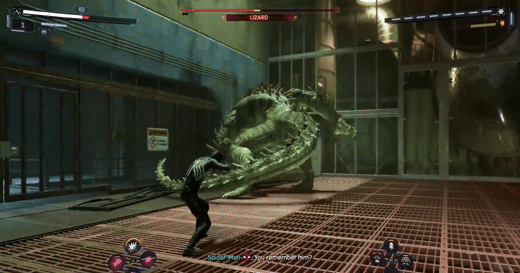
Recovery:
Since the contact frames are really long, the recovery frames are much shorter compared to other heavy or unblock-able attacks. The recovery frames last about 0.6s.
Interrupt:
Since this move is unblock-able, it cannot be interrupted and focuses on the player’s dodging skill. The attack is also has a small cone area of effect so the player might need to perform a couple of dodges to get out the cone area which further increases the skill check for this attack.
Attack 8: Vertical tail slam
This is the second attack that the Lizard can perform using its tail but this isn’t a heavy attack unlike the previous one. This is a quick tail slam that comes from the top with little time for anticipation as well as recovery allowing Lizard to quickly get in a hit.

Anticipation:
The anticipation time is about 1.2s which might seem long but doesn’t feel like it since the attack is not accompanied by a yellow or blue ring. These frames also feel short because it is a tail based attack; happening behind the main body of the creature; which makes it harder to see.
Recovery:
This is meant to be a quick light attack, so the recovery time here is also pretty short, about 0.6s.
Interrupt:
This move cannot be interrupted by the player and forces them to dodge, parry or block it very quickly.
Phase 4 design goals
- This is the actual boss fight and should feel like a culmination of the previous three phases. Use every attack previously introduced.
- Add a couple of new attacks and finish introducing the final enemy move-set to the player.
- Chain various attacks together in a single sequence to increase the skill check level on dodging, parrying and blocking to make this phase feel harder.
How is this phase harder than the previous phases?
- The sheer number of attacks that the player has to anticipate and respond to. Lizard has EIGHT attacks in his arsenal.
- Combining multiple and different type of attacks into a single sequence quickly increases the skill needed to deal with these incoming attacks. A couple of examples will be combining slash combo with crush attack and concrete projectile with wall crush.
- The recovery or idle time between attacks was also reduced. This directly leads to the Lizard feeling much more aggressive and difficult as attacks flow quickly into each other with minimal recovery time for the player.
3. Lizard Attack Sheet
After looking at all the attacks, here is a quick cheat sheet to quickly see and compare the anticipation, recovery and type of attacks.
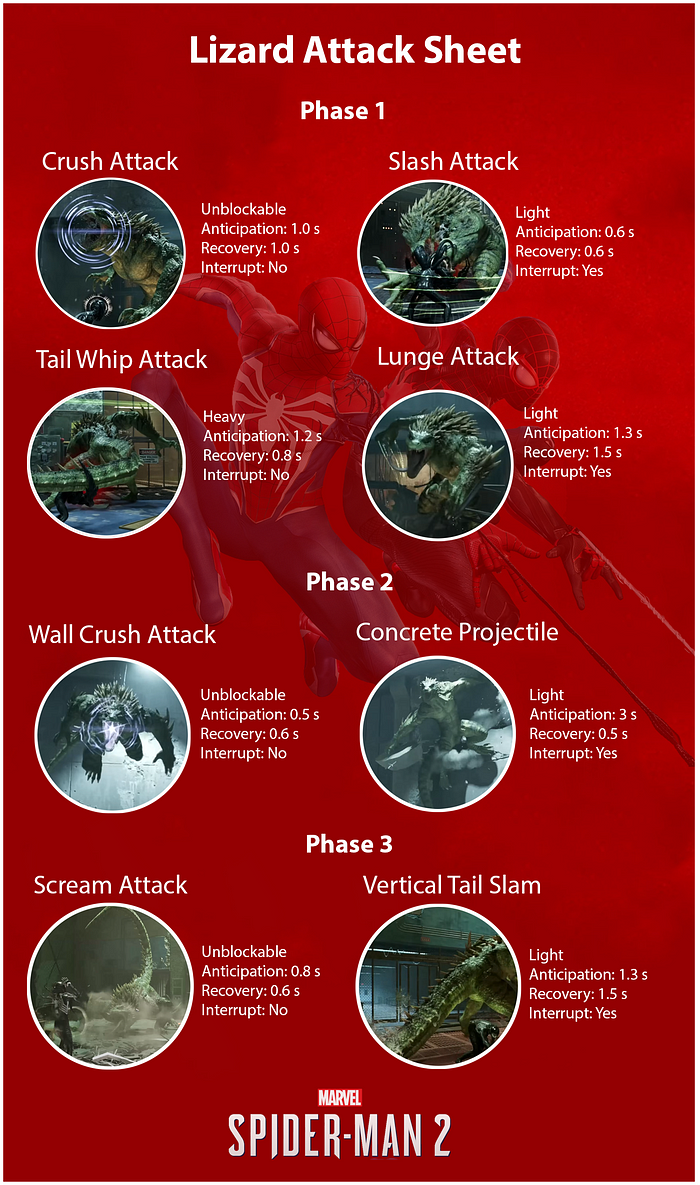
4. Balancing enemy attacks:
After understanding the entire move-set of the boss, let us take a quick look at the move-set balance. Three attacks are unblock-able (only dodge) , one is a heavy attack (dodge/parry) and four are light attacks (dodge/parry/block). Each type of attack checks a different skillset and different anticipation timing on each skill checks the player in different scenarios.
Seeing as one of the goals of the boss fight was to teach the player how to deal with unblock-able attacks, it would make sense to have a variety of them (in this case, three). To balance out the difficult unblock-able attacks, it makes sense to balance out with a larger number of lighter attacks (four in this case). To top it off, responding to just two types of attacks can quickly become boring for a multi-phase boss fight, so adding in a heavy attack adds variety to attack type but still keeps the number of attacks in the move-set from getting out of hand.
Range is another factor to consider when look at move-set balance. There are three close range attacks, three long range and a couple of mid-range attack to round out the move-set.
5. Does the Lizard boss fight have the characteristics of a good boss battle?
As mentioned in the first section, a well designed boss battle can have one or more of the characteristics listed below:
i. to test a player’s mastery of a set of current skills.
There are about four attacks in the Lizard’s move-set that test the parrying and blocking ability of the player. Different attacks require the Lizard to take different positions in the arena, thus testing the player’s mastery with melee combat as well as long range attacks like web projectiles and gadgets.
ii. to teach the player a new skill.
The fight teaches the player about unblock-able attacks and how they should focus on dodging in response to these attacks.
This is also the player’s first boss fight with the symbiote suit so the battle also provides a good testing arena for the player to learn and master venom suit skills.
iii. to surprise the player with a unique piece of gameplay experience.
While the player has had boss fights with multiple phases, hardly any of them had a chase sequence in them. Now add the use of newly gained symbiote abilities to this multi-phase fight and the Lizard boss fight becomes a standout and memorable boss in the memory of Spiderman players.
iv. to advance the game’s story.
Each phase is a narrative beat where during phase 1 and 2, Spiderman tries to reason with Dr. Connors who has transformed into the Lizard.
During phase 3, Kraven and Lizard create problems for Spiderman and he realizes that Lizard is beyond reasoning.
At last, during phase 4, Spiderman starts verbally attacking the Lizard before finally giving him the antidote towards the end of the fight and turning him back into Dr. Connors, thus the narrative implication of the entire sequence being that Lizard is not a threat anymore.
6. Good combat design takeaways from this boss fight
- Teach a new attack at the beginning of a phase of the fight and have the enemy use it frequently so that players have a lot of chances to get used to it.
- Slow buildup to the full enemy move-set. Teach a few attacks in every phase and have the final phase be the culmination of everything where the enemy uses their full move-set.
- Introduce something new as well as familiar after each phase of the fight.
- Skill check different player skills (both attacking and defending) with different moves.
- Chain previously introduced attacks into a single sequence to reduce recovery time and increase difficulty.
- Balance out the type of attacks and the skill checks they perform. For example, not all moves should skill check the player’s parrying or dodging abilities only. Some should also check how effectively the player can block or interrupt an attack. Also consider their ranges and anticipation/recovery frames while rounding out the move-set.
- Longer anticipation on larger attacks which uses the full body of the enemy rather than only one body part.
- Good reference for breaking up a straight up melee fight with a little bit of strategic play when lizard starts running around on the walls and the player needs to drag him to the ground
- Good example of enemy positioning. Do not let the player stun lock an enemy with continuous attacks. Instead, reposition the enemy so that they can start getting in some fresh attacks at the player.
7. Further resources:
To get more in-depth information about combat systems and boss battle designs in general, check out these articles and videos:

